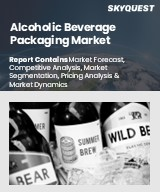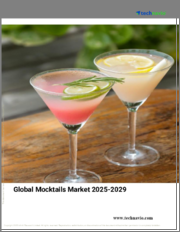
|
시장보고서
상품코드
1322269
세계의 알코올 음료 시장 평가: 유형별, 알코올 도수별, 포장별, 카테고리별, 유통 채널별, 지역별, 기회 및 예측(2016-2030년)Alcoholic Beverages Market Assessment, By Type, By Alcohol Content, By Packaging, By Category, By Distribution Channel, By Region, Opportunities, and Forecast, 2016-2030F |
||||||
세계 알코올 음료 시장 규모는 2022년 1조 7,100억 달러에서 2030년까지 2조 3,400억 달러에 달할 것으로 예상되며, 2023-2030년의 예측 기간 동안 연평균 4.01%의 성장률을 보일 것으로 전망됩니다. 시장 확대의 주요 요인 중 하나는 바쁜 생활과 스트레스가 많은 업무 일정으로 인한 긴장과 불안을 해소하기 위해 알코올성 음료에 대한 수요 증가와 여성들의 소비 트렌드 확대입니다. 또한, 세계적으로 카페, 펍, 클럽, 바, 호텔, 레스토랑이 확대되면서 알코올 음료 소비가 증가하고 있는 것도 시장 전망을 밝게 하고 있습니다. 또한, 프리미엄 및 저알코올 RTD 주류에 대한 일반 소비자 수요가 세계적으로 증가하고 있습니다. 이는 시장 성장을 가속화하고 사람들의 사교와 주말 모임의 추세를 높이고 있습니다.
또한, 대형마트, 슈퍼마켓, 전문점, 편의점, 온라인 등 다양한 유통채널을 통해 주류가 널리 보급되고 있는 점도 업계 경영자들에게 유리한 확장 가능성을 가져다주고 있습니다. 시장은 젊은 세대의 가향 알코올 음료에 대한 수요 증가로 인해 긍정적인 영향을 받고 있습니다. 이 외에도 소화관 건강 유지에 도움이 되는 맥주의 인기가 높아짐에 따라 시장이 확대되고 있습니다.
또한, 중국, 인도 등 신흥국에서 장인정신이 깃든 증류주에 대한 수요가 급증하면서 시장 성장이 기대되고 있습니다. 또한, 경쟁력 있는 가격으로 부가가치가 높은 하드 셀러 제품에 대한 수요 증가를 활용할 수 있는 기회가 시장에 제공되고 있습니다. 그러나 무알콜 음료에 대한 선호도 증가로 인해 산업 확대에 걸림돌로 작용하고 있습니다. 건강을 중시하는 소비자들을 위해 주요 기업들은 현재 저알코올 코디얼 및 알코올 음료 출시에 주력하고 있으며, 2021년 8월에는 가장 건강한 저알코올 맥주 중 하나인 '라임이 들어간 홀라 맥주'(알코올 도수 0.5%)가 Loah Beer Co.가 저알코올-무알코올 카테고리에 도입했습니다. 알코올 도수 0.5%를 목표로 효모, 홉, 맥아는 모두 알코올 맥주와 동일한 것을 사용했으며, 현재 영국 시장에서 판매되고 있는 저알코올 맥주 중 가장 낮은 칼로리, 낮은 당도를 자랑합니다.
프리미엄/슈퍼프리미엄 알코올 음료의 인기 상승
오늘날 세계 소비자들의 취향이 더욱 세련되고 독특하고 우수한 주류에 대한 수요가 증가함에 따라 최고급 주류에 대한 시장 수요가 증가하고 있습니다. 미국 증류주 협회의 데이터에 따르면 2021년까지 9 리터짜리 프리미엄 위스키 9 리터 케이스는 2,170 만 병, 프리미엄 보드카 9 리터 케이스는 2,110 만 병이 소비되었습니다. 슈퍼 프리미엄 위스키는 전년 대비 14.1%, 보드카는 13.9% 증가했습니다.
건강에 대한 관심이 높아지면서 기능성 프리미엄 알코올 음료가 개발되고 있습니다. 알코올은 다양한 천연 및 외래 성분을 함유하여 더 뛰어난 기능성을 발휘하는 경향이 있으며, 다양한 소비자를 끌어들이고 있습니다. 예를 들어, 영국의 프리미엄 진 브랜드 Whitley Neill은 2022년 3월 진 신제품으로 오리엔탈 스파이스 진(Oriental Spiced Gin)을 출시했습니다. 이 진에는 천국의 곡물, 고수, 생강, 생강, 칠리, 커민, 사프란, 후추 등 다양한 식물과 향신료가 포함되어 있습니다. 따라서 예측 기간 동안 프리미엄/슈퍼 프리미엄 알코올 음료의 인기가 높아짐에 따라 시장 수요가 증가할 것으로 예상됩니다.
이 보고서는 세계의 알코올 음료(Alcoholic Beverages) 시장에 대해 조사 분석하여 시장 규모와 예측, 시장 역학, 주요 기업 현황과 전망 등을 제공합니다.
목차
제1장 조사 방법
제2장 프로젝트의 범위와 정의
제3장 세계의 주류 시장에 대한 COVID-19의 영향
제4장 주요 요약
제5장 고객의 소리
- 인구통계(연령/코호트 분석 - 전후세대와 X세대, 밀레니얼 세대, Z세대, 성별, 소득 - 저, 중, 고, 지역, 국적 등)
- 시장 인지도와 제품 정보
- 브랜드 인지도와 로열티
- 구입 결정에서 고려되는 요소
- 구입 목적(개인 사용, 선물 물건)
- 구입 빈도
- 구입 매체
- 제품/브랜드 흡수 브랜드 앰베서더 또는 기업 마케팅 역할
제6장 세계의 주류 시장 전망(2016년-2030년)
- 시장 규모와 예측
- 금액
- 수량
- 유형별
- 맥주
- 와인
- 증류주
- 사이다 및 Flavoured Alcoholic Beverages(FABs)
- 기타
- 알코올 도수별
- 고
- 중
- 저
- 포장별
- 알루미늄 캔
- 파우치 포장
- 유리병
- 페트병
- 기타
- 카테고리별
- 대중용
- 프리미엄
- 유통 채널별
- 편의점
- 점내
- 술집
- 식료품점
- 인터넷 소매
- 슈퍼마켓
- 기타
- 지역별
- 북미
- 유럽
- 남미
- 아시아태평양
- 중동 및 아프리카
제7장 세계의 주류 시장 전망 : 지역별(2016년-2030년)
- 북미
- 유형별
- 알코올 도수별
- 포장별
- 카테고리별
- 유통 채널별
- 미국
- 캐나다
- 멕시코
- 유럽
- 독일
- 프랑스
- 이탈리아
- 영국
- 러시아
- 네덜란드
- 스페인
- 터키
- 폴란드
- 남미
- 브라질
- 아르헨티나
- 아시아태평양
- 인도
- 중국
- 일본
- 호주
- 베트남
- 한국
- 인도네시아
- 필리핀
- 중동 및 아프리카
- 아랍에미리트(UAE)
- 남아프리카공화국
- 기타
제8장 시장 매핑(2022년)
- 유형별
- 알코올 도수별
- 포장별
- 카테고리별
- 유통 채널별
- 지역별
제9장 거시환경과 산업 구조
- 수급 분석
- 수출입 분석
- 밸류체인 분석
- PESTEL 분석
- Porter의 Five Forces 분석
제10장 시장 역학
- 성장 촉진요인
- 성장 억제요인(과제, 성장 억제요인)
제11장 주요 기업 상황
- 시장 리더 주요 5개사 경쟁 매트릭스
- 시장 리더 주요 5개사 시장 매출 분석(2022년)
- 인수합병(M&A)/합작투자(JV)(해당하는 경우)
- SWOT 분석(시장 진출기업 5개사용)
- 특허 분석(해당하는 경우)
제12장 가격 분석
제13장 사례 연구
제14장 주요 기업 전망
- Anheuser-Busch InBev SA/NV
- Bacardi Limited
- Heineken NV
- Constellation Brands, Inc.
- Diageo plc
- Carlsberg A/S
- Molson Coors Beverage Company
- Pernod Ricard SA
- Olvi plc
- Suntory Group
제15장 전략적 추천 사항
제16장 당사에 대해/면책사항
LSH 23.08.18Global Alcoholic Beverages Market size was estimated at USD 1.71 trillion in 2022 and is projected to reach USD 2.34 trillion by 2030, growing at a CAGR of 4.01% for the forecast period between 2023 to 2030. One of the main drivers of the market's expansion is the increased demand for alcoholic beverages to ease the tension and anxiety brought on by busy lives and stressful job schedules coupled with growing consumption trends among women. Additionally, a positive market outlook is being provided by the rising consumption of alcoholic beverages as a result of the expansion of cafes, pubs, clubs, bars, hotels, and restaurants around the world. Additionally, there is a growing demand among the general public worldwide for premium, low ABV (alcohol by volume) ready-to-drink (RTD) alcoholic beverages. This is accelerating the market's growth and the rising trend of socializing and weekend gatherings among people.
In addition, the widespread accessibility of alcoholic beverages through various distribution channels, including hypermarkets, supermarkets, specialty, convenience, and online stores, provides industry operators with lucrative expansion potential. The market is being positively impacted by the younger generation's rising demand for flavored alcoholic beverages. Apart from this, the market is expanding because of the growing popularity of beer, which helps people keep a healthy digestive tract.
Furthermore, the alcoholic beverages market is anticipated to grow due to the surging demand for artisanal spirits in emerging economies like China and India. Additionally, there is an opportunity for the market to capitalize on the increasing demand for value-added hard seltzer products at competitive prices. However, the industry expansion is hindered by the rising preference for non-alcoholic beverages. To cater to health-conscious consumers, major players are now focusing on introducing cordials and alcoholic beverages with lower alcohol content. In August 2021, Hola Beer with Lime (0.5% ABV), one of the healthiest low-alcohol beers, was introduced to the low and no-alcohol category by Loah Beer Co. Aiming, especially at a 0.5% ABV, the new Hola Beer with Lime is brewed with all the same yeast, hops, and malts as alcoholic beer. It also has one of the lowest calorie and sugar contents of any low-alcohol beer currently available in the UK market.
Growing Popularity of Premium and Super-Premium Alcoholic Beverages
Global consumers today have more refined tastes and are constantly searching for unique and excellent alcoholic beverages resulting in greater market demand for alcoholic beverages of the highest caliber. In 2021 , 21.7 million 9-liter cases of premium whisky and 21.1 million 9-liter cases of premium vodka were consumed, as per the data by the Distilled Spirits Council of the United States. Additionally, Super-premium whisky and vodka both experienced year-over-year growth rates of 14.1% and 13.9%, respectively.
Functional premium alcoholic beverages have been developed as a result of the increase in health consciousness. Alcohol tends to have better functional qualities when various natural and exotic components are included, which attracts a wider range of consumers. For instance, the premium gin brand Whitley Neill in the United Kingdom introduced Oriental Spiced Gin as a new gin variety in March 2022. This gin contains a variety of botanicals and spices, including grains of paradise, coriander, ginger, chilli, cumin, saffron, and chilli. As a result, market demand is anticipated to be driven by the growing popularity of premium and super-premium alcoholic beverages throughout the forecast period.
Changing Lifestyles
People in emerging economies are experimenting with new forms of entertainment like nightclubs and pub hopping due to the growing urban population and increased disposable incomes. Additionally, sales of alcoholic beverages are driven by young individuals with wealthy families, substantial social media influence, and simple access to alcohol. Urban areas have more alcoholic beverage usage because of stressful employment and the idea that alcohol calms the mind, drives the demand for these beverages. Manufacturers of alcoholic beverages are often adding new flavours to their products. Customers are intrigued to test these products, which are appropriate for the alcoholic beverage business, especially millennials. To take benefit from the growing millennial population, in October 2022, three limited-edition unique experimental brews were created by Carlsberg Breweries A/S to mark the company's 175th anniversary.
Government Regulations/Initiatives
Governments typically require alcoholic beverage producers, distributors, and retailers to obtain licenses and permits to operate legally. These licenses may be specific to different types of alcoholic beverages, such as beer, wine, or spirits. The application process and requirements for obtaining licenses vary, including factors such as age restrictions, background checks, and adherence to specific regulations. Governments set standards for the production, quality, and safety of alcoholic beverages. The labelling requirements often include details such as alcohol content, ingredients, allergen information, health warnings, and origin. Age restrictions are enforced for the purchase and consumption of alcoholic beverages. The legal drinking age varies globally, aiming to protect public health and prevent underage drinking. Alcoholic beverages are subject to taxation and excise duties imposed by governments. The rates and structures of these taxes vary across countries and can significantly impact pricing, profitability, and consumer demand. Governments use taxation as a means to generate revenue and regulate alcohol consumption.
North America Expected to be the Fastest-Growing Market
This region leads the alcoholic beverage sector because a large majority of the population in North America is under the age of 25. Over the course of the forecast period, the market for alcoholic beverages is anticipated to grow due to the increased demand for premium alcoholic beverages. Due to rising disposable income, it is projected that the North American alcohol market will expand significantly. In the upcoming years, developing nations are anticipated to dominate the region's alcoholic beverage market. Due to customer perceptions of craft spirits as premium quality and the national notion of mindful drinking, craft beer and craft spirits are the segments with the strongest growth rates.
Wine consumption in North America has also been steadily increasing. The region has seen a rise in wine appreciation and wine culture, with consumers exploring a wide variety of wines from different regions and grape varieties. This trend has been supported by wine tourism, wine clubs, and a growing interest in wine education. According to the Wine Institute, a total of 822 million gallons of wine were consumed in the United States in 2022.
Impact of COVID-19
People's drinking patterns have substantially changed since the COVID-19 pandemic, shifting from pubs and restaurants to their homes. Alcohol is a common component of people's social lives, which COVID-19 has drastically affected. Overall, a few people did not change their drinking habits, but among those who did, their consumption increased by a larger percentage. According to early figures on government tax receipts, alcohol sales in Germany, the United Kingdom, and the United States rose by 3% to 5% in 2020 compared to 2019. This industry was badly impacted by the sharp decline in alcohol sales in bars and restaurants, while off-premises sales, such as those made in retail and online businesses, saw tremendous growth. For instance, online sales rose up to 234% in the United States.
Key Players Landscape and Outlook
The market is extremely competitive, and large competitors hold sizable market shares. Diageo, Anheuser-Busch InBev, Heineken Holding NV, Bacardi Limited, and Constellation Brands are some of the industry's biggest participants. The players in the market for alcoholic beverages employ a variety of business strategies to boost sales. These strategies include joint ventures, product innovations, and mergers and acquisitions. For instance, in March 2023, Pernod Ricard USA announced buying a majority stake in a flavored American Whiskey brand Skrewball. In the same month in 2023, Diageo completed its acquisition of a Philippines' dark rum- Don Papa Rum.
Table of Contents
1. Research Methodology
2. Project Scope & Definitions
3. Impact of COVID-19 on Global Alcoholic Beverages Market
4. Executive Summary
5. Voice of Customer
- 5.1. Demographics (Age/Cohort Analysis - Baby Boomers and Gen X, Millennials, Gen Z; Gender; Income - Low, Mid and High; Geography; Nationality; etc.)
- 5.2. Market Awareness and Product Information
- 5.3. Brand Awareness and Loyalty
- 5.4. Factors Considered in Purchase Decision
- 5.4.1. Brand Name
- 5.4.2. Pack Size
- 5.4.3. Price
- 5.4.4. Customisation Options
- 5.4.5. Packaging Type
- 5.4.6. Promotional Offers & Discounts
- 5.5. Purpose of Purchase (Personal Use, Gifting)
- 5.6. Frequency of Purchase
- 5.7. Medium of Purchase
- 5.8. Role of Brand Ambassador or Influencer Marketing on Product/Brand Absorption
6. Global Alcoholic Beverages Market Outlook, 2016-2030F
- 6.1. Market Size & Forecast
- 6.1.1. By Value
- 6.1.2. By Volume
- 6.2. By Type
- 6.2.1. Beer
- 6.2.2. Wine
- 6.2.3. Spirits
- 6.2.4. Ciders and Flavoured Alcoholic Beverages (FABs)
- 6.2.5. Others
- 6.3. By Alcohol Content
- 6.3.1. High
- 6.3.2. Medium
- 6.3.3. Low
- 6.4. By Packaging
- 6.4.1. Aluminium Cans/Tins
- 6.4.2. Pouch Packaging
- 6.4.3. Glass Bottles
- 6.4.4. Plastic Bottles
- 6.4.5. Others
- 6.5. By Category
- 6.5.1. Mass
- 6.5.2. Premium
- 6.6. By Distribution Channel
- 6.6.1. Convenience Stores
- 6.6.2. On Premises
- 6.6.3. Liquor Stores
- 6.6.4. Grocery Shops
- 6.6.5. Internet Retailing
- 6.6.6. Supermarkets
- 6.6.7. Others
- 6.7. By Region
- 6.7.1. North America
- 6.7.2. Europe
- 6.7.3. South America
- 6.7.4. Asia-Pacific
- 6.7.5. Middle East and Africa
- 6.8. By Company Market Share (%), 2022
7. Global Alcoholic Beverages Market Outlook, By Region, 2016-2030F
- 7.1. North America*
- 7.1.1. By Type
- 7.1.1.1. Beer
- 7.1.1.2. Wine
- 7.1.1.3. Spirits
- 7.1.1.4. Ciders and Flavoured Alcoholic Beverages (FABs)
- 7.1.1.5. Others
- 7.1.2. By Alcohol Content
- 7.1.2.1. High
- 7.1.2.2. Medium
- 7.1.2.3. Low
- 7.1.3. By Packaging
- 7.1.3.1. Aluminium Cans/Tins
- 7.1.3.2. Pouch Packaging
- 7.1.3.3. Glass Bottles
- 7.1.3.4. Plastic Bottles
- 7.1.3.5. Others
- 7.1.4. By Category
- 7.1.4.1. Mass
- 7.1.4.2. Premium
- 7.1.5. By Distribution Channel
- 7.1.5.1. Convenience Stores
- 7.1.5.2. On Premises
- 7.1.5.3. Liquor Stores
- 7.1.5.4. Grocery Shops
- 7.1.5.5. Internet Retailing
- 7.1.5.6. Supermarkets
- 7.1.5.7. Others
- 7.1.6. United States*
- 7.1.6.1. By Type
- 7.1.6.1.1. Beer
- 7.1.6.1.2. Wine
- 7.1.6.1.3. Spirits
- 7.1.6.1.4. Ciders and Flavoured Alcoholic Beverages (FABs)
- 7.1.6.1.5. Others
- 7.1.6.2. By Alcohol Content
- 7.1.6.3. High
- 7.1.6.4. Medium
- 7.1.6.5. Low
- 7.1.6.6. By Packaging
- 7.1.6.6.1. Aluminium Cans/Tins
- 7.1.6.6.2. Pouch Packaging
- 7.1.6.6.3. Glass Bottles
- 7.1.6.6.4. Plastic Bottles
- 7.1.6.6.5. Others
- 7.1.6.7. By Category
- 7.1.6.7.1. Mass
- 7.1.6.7.2. Premium
- 7.1.6.8. By Distribution Channel
- 7.1.6.8.1. Convenience Stores
- 7.1.6.8.2. On Premises
- 7.1.6.8.3. Liquor Stores
- 7.1.6.8.4. Grocery Shops
- 7.1.6.8.5. Internet Retailing
- 7.1.6.8.6. Supermarkets
- 7.1.6.8.7. Others
- 7.1.7. Canada
- 7.1.8. Mexico
- 7.1.1. By Type
All segments will be provided for all regions and countries covered
- 7.2. Europe
- 7.2.1. Germany
- 7.2.2. France
- 7.2.3. Italy
- 7.2.4. United Kingdom
- 7.2.5. Russia
- 7.2.6. Netherlands
- 7.2.7. Spain
- 7.2.8. Turkey
- 7.2.9. Poland
- 7.3. South America
- 7.3.1. Brazil
- 7.3.2. Argentina
- 7.4. Asia-Pacific
- 7.4.1. India
- 7.4.2. China
- 7.4.3. Japan
- 7.4.4. Australia
- 7.4.5. Vietnam
- 7.4.6. South Korea
- 7.4.7. Indonesia
- 7.4.8. Philippines
- 7.5. Middle East & Africa
- 7.5.1. UAE
- 7.5.2. South Africa
- 7.5.3. Others
8. Market Mapping, 2022
- 8.1. By Type
- 8.2. By Alcohol Content
- 8.3. By Packaging
- 8.4. By Category
- 8.5. By Distribution Channel
- 8.6. By Region
9. Macro Environment and Industry Structure
- 9.1. Supply Demand Analysis
- 9.2. Import Export Analysis
- 9.3. Value Chain Analysis
- 9.4. PESTEL Analysis
- 9.4.1. Political Factors
- 9.4.2. Economic System
- 9.4.3. Social Implications
- 9.4.4. Technological Advancements
- 9.4.5. Environmental Impacts
- 9.4.6. Legal Compliances and Regulatory Policies (Statutory Bodies Included)
- 9.5. Porter's Five Forces Analysis
- 9.5.1. Supplier Power
- 9.5.2. Buyer Power
- 9.5.3. Substitution Threat
- 9.5.4. Threat from New Entrant
- 9.5.5. Competitive Rivalry
10. Market Dynamics
- 10.1. Growth Drivers
- 10.2. Growth Inhibitors (Challenges and Restraints)
11. Key Players Landscape
- 11.1. Competition Matrix of Top Five Market Leaders
- 11.2. Market Revenue Analysis of Top Five Market Leaders (in %, 2022)
- 11.3. Mergers and Acquisitions/Joint Ventures (If Applicable)
- 11.4. SWOT Analysis (For Five Market Players)
- 11.5. Patent Analysis (If Applicable)
12. Pricing Analysis
13. Case Studies
14. Key Players Outlook
- 14.1. Anheuser-Busch InBev SA/NV
- 14.1.1. Company Details
- 14.1.2. Key Management Personnel
- 14.1.3. Products & Services
- 14.1.4. Financials (As reported)
- 14.1.5. Key Market Focus & Geographical Presence
- 14.1.6. Recent Developments
- 14.2. Bacardi Limited
- 14.3. Heineken NV
- 14.4. Constellation Brands, Inc.
- 14.5. Diageo plc
- 14.6. Carlsberg A/S
- 14.7. Molson Coors Beverage Company
- 14.8. Pernod Ricard SA
- 14.9. Olvi plc
- 14.10. Suntory Group



















